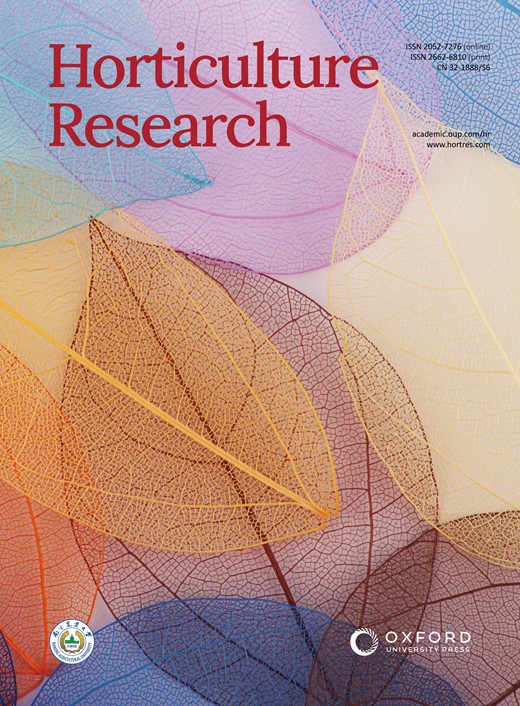Combined genomic, transcriptomic, and metabolomic analyses provide insights into the fruit development of bottle gourd (Lagenaria siceraria)
IF 8.7
1区 农林科学
Q1 Agricultural and Biological Sciences
引用次数: 0
Abstract
Bottle gourd (Lagenaria siceraria (Molina) Standl) is a widely distributed Cucurbitaceae species, but gaps and low-quality assemblies have limited its genomic study. To address this, we assembled a nearly complete, high-quality genome of the bottle gourd (Pugua) using PacBio HiFi sequencing and Hi-C correction. The genome, being 298.67 Mb long with a ContigN50 of 28.55 Mb, was identified to possess 11 chromosomes, 11 centromeres, 18 telomeres, and 24,439 predicted protein-coding genes; notably, gap-free telomere-to-telomere assembly was accomplished for seven chromosomes. Based on the Pugua genome, the transcriptomic and metabolomic combined analyses revealed that amino acids and lipids accumulate during the expansion stage, while sugars and terpenoids increase during ripening. GA4 and genes of the Aux/IAA family mediate fruit expansion and maturation, while cell wall remodeling is regulated by factors such as XTHs, EXPs, polyphenols, and alkaloids, contributing to environmental adaptation. GGAT2 was positively correlated with glutamate, a source of umami, and SUS5 and SPS4 expression aligned with sucrose accumulation. This study provides a valuable genetic resource for bottle gourd research, enhancing the understanding of Cucurbitaceae evolution and supporting further studies on bottle gourd development, quality, and genetic improvement.结合基因组学、转录组学和代谢组学分析,为葫芦(Lagenaria siceraria)果实发育提供了新的见解。
葫芦(Lagenaria siceraria (Molina) Standl)是葫芦科植物中分布较广的一种,但其基因组研究存在一定的缺口和低质量组装。为了解决这个问题,我们使用PacBio HiFi测序和Hi-C校正技术组装了一个几乎完整的高质量葫芦(Pugua)基因组。该基因组长298.67 Mb, ContigN50为28.55 Mb,包含11条染色体、11个着丝粒、18个端粒和24439个预测蛋白编码基因;值得注意的是,7条染色体完成了端粒到端粒的无间隙组装。基于普瓜基因组,转录组学和代谢组学联合分析显示,氨基酸和脂质在扩张阶段积累,而糖和萜类在成熟阶段增加。GA4和Aux/IAA家族基因介导果实膨胀和成熟,细胞壁重塑受XTHs、EXPs、多酚和生物碱等因子调控,有助于适应环境。GGAT2与鲜味来源谷氨酸呈正相关,而SUS5和SPS4的表达与蔗糖积累一致。该研究为葫芦研究提供了宝贵的遗传资源,有助于加深对葫芦科植物进化的认识,为进一步研究葫芦的发育、品质和遗传改良提供依据。
本文章由计算机程序翻译,如有差异,请以英文原文为准。
求助全文
约1分钟内获得全文
求助全文
来源期刊

Horticulture Research
Biochemistry, Genetics and Molecular Biology-Biochemistry
CiteScore
11.20
自引率
6.90%
发文量
367
审稿时长
20 weeks
期刊介绍:
Horticulture Research, an open access journal affiliated with Nanjing Agricultural University, has achieved the prestigious ranking of number one in the Horticulture category of the Journal Citation Reports ™ from Clarivate, 2022. As a leading publication in the field, the journal is dedicated to disseminating original research articles, comprehensive reviews, insightful perspectives, thought-provoking comments, and valuable correspondence articles and letters to the editor. Its scope encompasses all vital aspects of horticultural plants and disciplines, such as biotechnology, breeding, cellular and molecular biology, evolution, genetics, inter-species interactions, physiology, and the origination and domestication of crops.
 求助内容:
求助内容: 应助结果提醒方式:
应助结果提醒方式:


